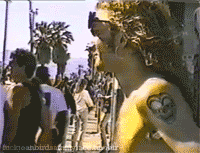When the Suffering Undoes the Artist
8 comments Jul 10, 2009 | Article, Featured, Layne Staley, Mike Starr, News, Pictures
When the Suffering Undoes the Artist
By JON PARELES
Published NY Times: Sunday, April 28, 2002
(NY Times Article)
LAYNE STALEY lived fast, died young and probably did not leave a beautiful corpse when he was found dead in his Seattle apartment on April 19, a few days deceased with heroin paraphernalia nearby. He was the lead singer of Alice in Chains, the grunge band that sold more than 10 million albums and EP’s in the 1990’s, and he had sung as often as not about drugs and death.
”What in God’s name have you done?/Stick your arm for some real fun,” he sang in ”God Smack” on ”Dirt,” the band’s best, best-selling and most chilling album, which was released in September 1992. Like Tupac Shakur, Mr. Staley prophesied his own death in a way that now makes his songs all too realistic.
For some reason, Alice in Chains never quite commanded the cachet that was attached to Seattle bands like Nirvana, Soundgarden and Pearl Jam. It hadn’t struggled on independent labels, and it had relatively quick success. Although its songs had all the somber desolation of its fellow grunge bands, Jerry Cantrell’s guitar riffs and Mr. Staley’s nasal yowl quickly pushed Alice in Chains onto mainstream radio, without the kind of resistance that makes underground legends.
Mr. Staley’s death at 34 may well draw attention to his band’s most grimly powerful songs. But it would be a shame if his addiction became a kind of credential — that the songs were more genuine and real because they were about the drugs that killed him.
A Romantic ideology that predates rock glorifies the self-destructive artist as someone who’s too honest and delicate for this world. As the myth goes, artists use drugs or alcohol to free up inspiration and to insulate their sensitive souls from ordinary life. (It’s not just that they hang out at odd hours with other creatures of the night, or get bored or stuck and fall into bad habits.)
Artists are perceptive, but they choose to write songs (or make movies or paint pictures) rather than simply keeping private diaries. The myth doesn’t recognize a more hard-nosed side of artists: they are also stubborn egomaniacs who are mysteriously — and sometimes correctly — certain that the world needs to know all about the figments of their imaginations and who gear their lives to getting those figments into circulation. It’s not an easy job, and its stresses can take their toll.
The suicides of Kurt Cobain and Ian Curtis (not to mention Sylvia Plath) and the youthful deaths of Shakur, Jimi Hendrix, Jim Morrison, the Notorious B.I.G., Charlie Parker or Janis Joplin are too often seen as certifying the artists’ art instead of merely bringing it to a sudden end. Often, artists provide vicarious experience for audiences. Gangsta rap has disseminated the lore of drug-dealing and gunfighting, mixing cautionary tales with cheap thrills; from the Velvet Underground to Eric Clapton to Alice in Chains, bands have examined the lure of drugs. When songs sound like first-person accounts, fans may want to believe that they’re hearing about lived experiences, not just observations coupled with imagination. The artist who’s ”keepin’ it real” becomes the stunt double for a more sheltered listener.
And when someone dies in the way their songs predicted, like Mr. Staley or Shakur, audiences can listen in morbid fascination to artists who sacrificed themselves to bring back tidings of mortality.
Yet for every musician who manages to transmute personal suffering into great performances, like Billie Holiday, there are more who are only human, whose excess or misery undoes their art. Mr. Staley was one of them. He, and his songs, would have been better off glimpsing the abyss than falling into it.
There was an ominous immediacy to the most memorable Alice songs, a tone of desolation combined with acceptance, as if the music was already coming from beyond the grave. That tone may have been a close reflection of Mr. Staley’s daily dread. Yet contrary to the myth of noble self-destruction, the music was not some direct impression of a haunted life magically caught by microphones and pressed onto disks. It was a fabrication, created through skill and instinct and shaped by choices of chords and timbres, amplifiers and pedals. It had as much to do with the band’s main composer, Mr. Cantrell, as it did with Mr. Staley’s struggles.
Again and again, the band’s songs described the hold of addiction and its consequences. On the 1994 EP ”Jar of Flies,” Mr. Staley sang ”Swing on This,” in which friends and family say, ”Come home,” but he responds: ”I’m just fine/ Little skinny, O.K./ I’m asleep anyway.”
Convincing as they were, the songs were still only reports from the edge, not field recordings. And if Mr. Staley or his fans thought that he had to stay messed up to maintain his bleak insights, they were wrong. He could have been realistic without being autobiographical.
Mr. Staley held on from the formation of the band in 1987, through a recording career that began in 1990, and through the band’s last tour, as a Lollapalooza headliner, in 1993, to a six-month breakup in 1994. After regrouping, the four-man band had one more album in it, ”Alice in Chains” in 1995. (Without explanation, the cover showed a three-legged dog.) There was one more significant live show; following three years offstage, the band performed on ”MTV Unplugged” in 1996, where a rail-thin Mr. Staley wore shades and sang with a fraction of his old voice. A Rolling Stone interview that year detailed the band’s resentment of an increasingly shaky Staley and noted his needle marks.
In 1998, the other three members of Alice in Chains and their producer got together without Mr. Staley, to record, ”Boggy Depot,” an album of new songs under Mr. Cantrell’s name. And at the end of the decade, Columbia Records apparently despaired of getting any more from the band. As if to wring full value from Alice in Chains’ recording contract, it released a boxed set, a live album and a greatest-hits collection. The albums already felt like memorials.
In the end, Mr. Staley wasn’t cool because he died a junkie’s death after a long downward spiral. He was only cool while he could still sing about it.
Photos: Layne Staley of Alice in Chains: he was found dead on April 19. (Ebet Roberts)(pg. 1); Tupac Shakur: like Layne Staley, he prophesied his own death. (Death Row Records)(pg. 38)
More on NYTimes


















Nasally? (To the author): bro his voice was majestic and an angelic powerhouse of thunder and pain. Definitely not nasal but hey to each his own (opinion)
Also, saying that he sang with a “fraction of his old voice” in the unplugged show is just….false. Maybe he looked weaker but his voice was powerful af. Unplugged shows (live to boot) don’t have the backing of layered vocals and multiple attempts and corrections and heavy electric guitars. Ofcourse he’s gonna sound different.
I’m pestered by your writings but I accept it as such. An opinion (Just a wrong one )
Nasally? (To the author): bro his voice was majestic and an angelic powerhouse of thunder and pain. Definitely not nasal but hey to each his own (opinion)
I miss him……
I don’t think layne enjoyed much. he seems like a very miserable guy that couldn’t allow himself to know happiness. I’m sure he had his moments but overall I’d guess he would be glad it ended
What do you think of the response writer David de Sola received from Layne’s sister Liz, in regards to Rubio’s alleged last interview? His blog about his intention to dispute Rubio’s book and Mike Starr’s Unchained book is interesting. Personally, I hope he can interview the family, band and others to put the real story out there and clear up all of the rumors.
Damm… Fuck what people say about your drug adiction, no one has the right to tell you how you should live… only on this fucked up distorced society… I just hope you enjoyed the time you spent here and i wish it was more but it would be selfish to ask someone to stay when they dont want to… learning that everyday!
For me your are still the greatest, coolest guy you always were… I will never forget you becus your soul is printed in my heart!
Well said, thank you
Superb blog post, I have book marked this internet site so ideally I’ll see much more on this subject in the foreseeable future!